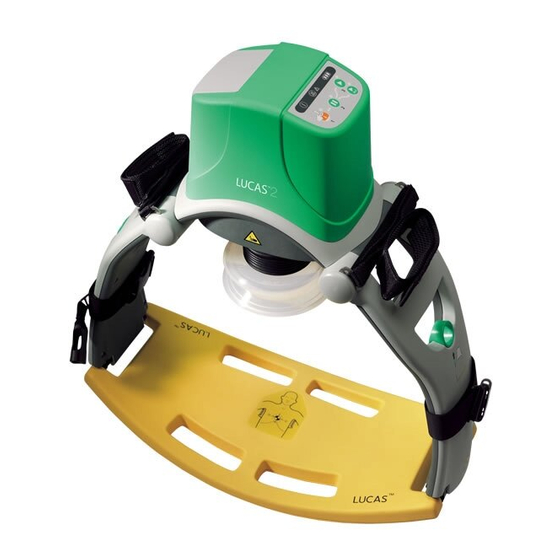
Table of Contents
Advertisement
Quick Links
LUCAS 2
®
Skills to be achieved:
· Explain the rationale for using the LUCAS 2 Device
· Be able to demonstrate appropriate placement, operation, and troubleshooting of the
LUCAS 2 Device
Theoretical knowledge to be covered:
· Indications for use
· Contra-indications
· Anatomy of the device
· How to use the device
Answer the following questions:
· What is the LUCAS 2 Device?
· When should the LUCAS 2 Device be used?
· How does the LUCAS 2 Device work?
· How do you adjust the suction cup/plunger placement?
· How do you check the battery level?
· How do you change the battery?
· Which parts are disposable and how do you clean the device?
What is the LUCAS 2 Mechanical Chest Compression Device?
The Lucas 2 Device is designed to provide effective and consistent automated external
chest compressions to patients over the age of 12 suffering from non traumatic cardiac
arrest.
When should the LUCAS 2 be used?
For inclusion within the 2Cheer study, the LUCAS 2 Device should be used where manual
chest compressions would otherwise be used, AND if:
- age under 12-70yr
AND meets ALL of the following criteria:
•
the cardiac arrest is likely to be of primary cardiac or respiratory cause
•
the cardiac arrest was witnessed by a bystander or paramedic or hospital
staff member
•
chest compressions commenced within 10 minutes
•
initial cardiac rhythm of ventricular fibrillation (VF)
•
immediate availability of a mechanical CPR device with paramedic staff
•
the cardiac arrest duration (collapse to arrival at ED) has been < 60minutes
OR meets ONE of the following criteria:
•
Severe hypothermia (<32°C) due to accidental exposure
•
Severe overdose with β-blockers, tricyclic antidepressants, digoxin or other
agents causing profound reversible myocardial depression and/or cardiac
rhythm disturbance
•
Any other cause where there is likely to be reversibility of the cardiac arrest if
an artificial circulation can be provided (e.g. massive pulmonary embolism)
Mechanical Chest Compression Device
Advertisement
Table of Contents

Subscribe to Our Youtube Channel
Summary of Contents for Stryker LUCAS 2
- Page 1 12 suffering from non traumatic cardiac arrest. When should the LUCAS 2 be used? For inclusion within the 2Cheer study, the LUCAS 2 Device should be used where manual chest compressions would otherwise be used, AND if: - age under 12-70yr AND meets ALL of the following criteria: •...
- Page 2 How does the LUCAS 2 Device work? The LUCAS 2 Device provides automated chest compressions at a rate of 100 per minute, to a depth of 4-5cm, and weighs 7.8 kg (with battery). It has an equal compression/ decompression time, and has an average battery operation time of 45 minutes.
- Page 3 4) Remove the Backboard (B) and place it under the patient’s back just below the axillae level, to permit the plunger to be placed at the lower half of the sternum. 5) Remove the Compression (C) device from the bag, pulling the release pins (opening the attachment claws) and then attach the device to backboard, listening for the “click”...
- Page 4 10) Follow-on (F) procedures, such as airway management, IV access, defibrillation, placement of the LUCAS 2 neck strap (to help prevent movement of the device on the patient), securing of the patients hands with the wrist straps, and transport of the patient can all occur with the LUCAS 2 device in operation.
- Page 5 1) The suction cup should be disposed of after each use. 2) The LUCAS 2 device should not be immersed in water. The device, backboard and straps can be cleaned by wiping down with a mild soap or disinfectant solution.













Need help?
Do you have a question about the LUCAS 2 and is the answer not in the manual?
Questions and answers